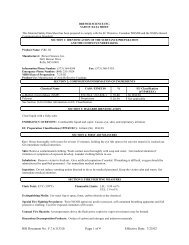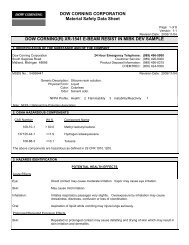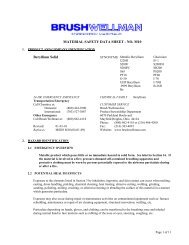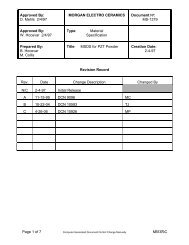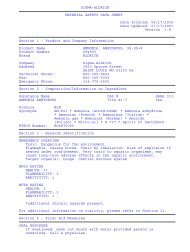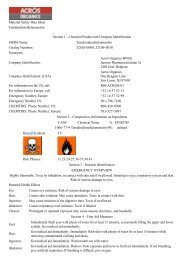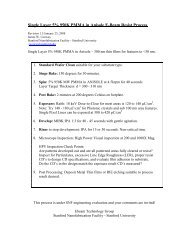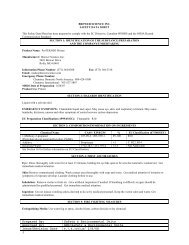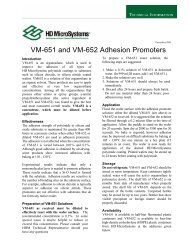Radiation tolerant sensors for the ATLAS pixel detector
Radiation tolerant sensors for the ATLAS pixel detector
Radiation tolerant sensors for the ATLAS pixel detector
Create successful ePaper yourself
Turn your PDF publications into a flip-book with our unique Google optimized e-Paper software.
Nuclear Instruments and Methods in Physics Research A 466 (2001) 327–334<br />
<strong>Radiation</strong> <strong>tolerant</strong> <strong>sensors</strong> <strong>for</strong> <strong>the</strong> <strong>ATLAS</strong> <strong>pixel</strong> <strong>detector</strong> $<br />
Abstract<br />
R. Wunstorf*<br />
Universit .at Dortmund, Lehrstuhl f .ur Experimentelle Physik IV, D-44227 Dortmund, Germany<br />
For <strong>the</strong> <strong>ATLAS</strong> Pixel Collaboration<br />
The <strong>pixel</strong> <strong>detector</strong> in <strong>the</strong> <strong>ATLAS</strong> experiment at <strong>the</strong> LHC, Geneva, is an important <strong>detector</strong> component <strong>for</strong> high<br />
resolution tracking and vertex identification. For this demanding task <strong>the</strong> hybrid <strong>pixel</strong> <strong>detector</strong> with silicon <strong>sensors</strong> has<br />
to work in a very harsh radiation environment with up to 3.5 10 14 n eq/cm 2 per year. On <strong>the</strong> basis of<strong>the</strong> known<br />
radiation effects a dual-track strategy was followed <strong>for</strong> <strong>the</strong> development of radiation <strong>tolerant</strong> silicon <strong>pixel</strong> <strong>sensors</strong>. The<br />
<strong>ATLAS</strong> <strong>pixel</strong> collaboration successfully developed <strong>the</strong> radiation hard sensor design which meets <strong>the</strong> challenging<br />
requirements <strong>for</strong> <strong>the</strong> <strong>ATLAS</strong> <strong>pixel</strong> <strong>detector</strong>. In parallel, <strong>the</strong> hardening of <strong>the</strong> silicon itself was followed within <strong>the</strong> ROSE<br />
collaboration, which developed <strong>the</strong> radiation <strong>tolerant</strong> DOFZ-silicon with oxygen enrichment by diffusion. Taking all<br />
<strong>the</strong> results toge<strong>the</strong>r <strong>the</strong> radiation <strong>tolerant</strong> silicon <strong>sensors</strong> have been designed, produced and showed excellent<br />
per<strong>for</strong>mance be<strong>for</strong>e and after irradiation. # 2001 Elsevier Science B.V. All rights reserved.<br />
PACS: 29.40.g; 29.40.W; 85.30.D; 61.80<br />
Keywords: <strong>ATLAS</strong>; Tracking; Detector; Silicon; Pixel; <strong>Radiation</strong> hardness; <strong>Radiation</strong> damage<br />
1. Introduction<br />
The <strong>ATLAS</strong> <strong>detector</strong> will be one of<strong>the</strong> two<br />
omni-purpose <strong>detector</strong>s which are being built <strong>for</strong><br />
<strong>the</strong> Large Hadron Collider at CERN, Geneva.<br />
Besides <strong>the</strong> high energy of<strong>the</strong> colliding protons of<br />
2 7 TeV <strong>the</strong> high event rate ofaround 25<br />
minimum bias events per bunch crossing every<br />
25 ns challenges <strong>the</strong> technical realization ofall<br />
<strong>detector</strong> components. To separate <strong>the</strong> different<br />
events and <strong>the</strong>ir vertices within one bunch crossing<br />
$ Work supported by BMBF under Contract 05H8PEA1.<br />
*Corresponding author. Tel.: +49-231-7553-544; fax: +49-<br />
231-7553-688.<br />
E-mail address: wunstorf@physik.uni-dortmund.de<br />
(R. Wunstorf).<br />
0168-9002/01/$ - see front matter # 2001 Elsevier Science B.V. All rights reserved.<br />
PII: S 0168-9002(01)00568-X<br />
<strong>the</strong> Inner Detector of<strong>ATLAS</strong> will have, besides<br />
<strong>the</strong> TRD and SCT at outer radii, a high resolution<br />
<strong>pixel</strong> <strong>detector</strong> [1,2].<br />
The <strong>ATLAS</strong> <strong>pixel</strong> <strong>detector</strong> will measure true<br />
space points in <strong>the</strong> two barrel layers at 10.1 cm and<br />
13.2 cm radius plus <strong>the</strong> so-called B-layer at a radius<br />
of4.3 cm and 5 disks up to z ¼ 92:6cm<br />
and |Z|=2.5. The B-layer was added later to <strong>the</strong><br />
<strong>pixel</strong> system in order to allow better impact<br />
parameter resolution <strong>for</strong> B-physics in <strong>the</strong> first 3<br />
years at reduced luminosity. The decision to build<br />
<strong>the</strong> B-layer with a silicon <strong>pixel</strong> <strong>detector</strong> was taken in<br />
1996, because <strong>pixel</strong> <strong>detector</strong>s can operate in<br />
this environment ofextremely high particle rates<br />
without ghost hits and with good S/N ratios due to<br />
<strong>the</strong> small <strong>pixel</strong> size of50 mm 300 mm. The<br />
challenge to build a silicon <strong>pixel</strong> <strong>detector</strong>, which
328<br />
R. Wunstorf / Nuclear Instruments and Methods in Physics Research A466 (2001) 327–334<br />
will work in <strong>the</strong> LHC environment was taken up by<br />
<strong>the</strong> <strong>ATLAS</strong> <strong>pixel</strong> collaboration. The focus of this<br />
article is <strong>the</strong> development of<strong>the</strong> radiation <strong>tolerant</strong><br />
silicon <strong>pixel</strong> <strong>sensors</strong> <strong>for</strong> <strong>the</strong> <strong>ATLAS</strong> experiment.<br />
Fig. 1. Illustration of<strong>the</strong> strategy followed by <strong>the</strong> development<br />
ofradiation <strong>tolerant</strong> silicon <strong>sensors</strong>.<br />
Table 1<br />
Overview of<strong>the</strong> sensor requirements <strong>for</strong> <strong>the</strong> <strong>ATLAS</strong> <strong>pixel</strong> <strong>detector</strong><br />
The overall strategy, as shown in Fig. 1, was to<br />
follow <strong>the</strong> different tasks concerning <strong>the</strong> design<br />
and material separately. From earlier systematic<br />
radiation damage studies ofsilicon <strong>detector</strong>s <strong>the</strong><br />
radiation induced material changes were known<br />
(e.g. Ref. [3]) and could be taken into account <strong>for</strong><br />
<strong>the</strong> development of<strong>the</strong> <strong>pixel</strong> sensor design. Parallel<br />
to this work within <strong>the</strong> <strong>ATLAS</strong> collaboration,<br />
members of<strong>the</strong> <strong>pixel</strong> collaboration were, from <strong>the</strong><br />
very beginning actively involved in <strong>the</strong> world wide<br />
initiative on developing more radiation hard<br />
silicon material, <strong>the</strong> ROSE collaboration [4]. The<br />
results from <strong>the</strong> two separate R&D tasks, <strong>pixel</strong><br />
sensor design and radiation <strong>tolerant</strong> silicon material<br />
<strong>for</strong> <strong>detector</strong>s were taken toge<strong>the</strong>r <strong>for</strong> <strong>the</strong><br />
prototyping, which finally led to <strong>the</strong> production of<br />
<strong>ATLAS</strong> <strong>pixel</strong> <strong>sensors</strong>.<br />
2. Design considerations<br />
Requirements Design features<br />
A number ofdifferent requirements have to be<br />
taken into account when designing a silicon sensor<br />
<strong>for</strong> such a challenging application as <strong>the</strong> <strong>ATLAS</strong><br />
<strong>pixel</strong> <strong>detector</strong>. Table 1 gives an overview of<strong>the</strong><br />
different but sometimes interrelated issues using a<br />
simplified classification. This long list shows that it<br />
is not possible to just order <strong>the</strong> suitable devices off<strong>the</strong>-shelf.<br />
Especially, none of <strong>the</strong> existing experiments<br />
until now required such radiation-<strong>tolerant</strong><br />
Module issues Small <strong>pixel</strong> size fitting <strong>the</strong> read-out cell 50 mm 400 mm (B-layer: 50 mm 300 mm)<br />
Small sensor thickness 250 mm (B-layer: 200 mm)<br />
No dead area between FE-chips Elongated resp. ganged <strong>pixel</strong>s (B-layer: uni-sized <strong>pixel</strong>s<br />
with MCMD)<br />
Compatible with bump bonding Silicon nitride passivation with 12 mm diameter opening<br />
Quality assurance Testability on wafer level Bias grid with punch-through connection to every<br />
<strong>pixel</strong> cell<br />
Coping with missing bumps Bias grid with punch-through connection to every<br />
<strong>pixel</strong> cell<br />
<strong>Radiation</strong> tolerance Edges on ground potential after type conversion n–in–n sensor with guard rings only on <strong>the</strong> p-side<br />
Increase ofoxide charge without excess current<br />
or noise<br />
p-spray isolation<br />
High break down voltages be<strong>for</strong>e and after<br />
irradiation<br />
Moderated p-spray isolation
R. Wunstorf / Nuclear Instruments and Methods in Physics Research A466 (2001) 327–334 329<br />
<strong>sensors</strong>. There<strong>for</strong>e, it was <strong>the</strong> task of <strong>the</strong> <strong>ATLAS</strong><br />
<strong>pixel</strong> sensor group to start <strong>the</strong> necessary R&D<br />
work on <strong>the</strong> basis of<strong>the</strong> known radiation induced<br />
effects.<br />
As predicted in 1990 and later on, observed<br />
n-type silicon bulk converts, at room temperature<br />
at a fluence ofaround 10 13 neq/cm 2 , to a p-type<br />
behavior [5,6]. The main consequence ofthis is that<br />
<strong>the</strong> sensor <strong>for</strong> <strong>the</strong> <strong>ATLAS</strong> Pixel Detector will be<br />
built as n + –in–n devices with only one guard-ring<br />
structure on <strong>the</strong> p-side. This allows <strong>the</strong> whole n-side<br />
including <strong>the</strong> edges of<strong>the</strong> sensor to be kept on<br />
ground potential and prevents sparking from <strong>the</strong><br />
sensor bias (up to 600 V) into <strong>the</strong> FE-chip which<br />
may be as close as 10 mm to <strong>the</strong> sensor. Measuring<br />
<strong>the</strong> radiation induced change of<strong>the</strong> silicon resistivity,<br />
e.g. with a four-point probe, in <strong>the</strong>rmal<br />
equilibrium, shows that <strong>the</strong> resistivity increases<br />
reaching a value close to intrinsic [7]. This high<br />
resistivity is <strong>the</strong> main reason that silicon <strong>detector</strong>s<br />
work after radiation induced type conversion without<br />
a guard-ring structure on <strong>the</strong> n-side [8].<br />
The n + –in–n sensor requires, ofcourse, a<br />
p-isolation on <strong>the</strong> structured n-side. There<strong>for</strong>e,<br />
different isolation options of<strong>the</strong> p-stop and pspray<br />
techniques were investigated systematically.<br />
Device simulations were per<strong>for</strong>med, especially<br />
concerning <strong>the</strong> electric field distribution and <strong>the</strong><br />
development under irradiation to minimize <strong>the</strong><br />
risk ofearly breakdown [9]. Both isolation<br />
techniques were realized within <strong>the</strong> wafer layout<br />
of<strong>the</strong> first prototype wafer. As discussed in<br />
Ref. [10], <strong>for</strong> p-stop designs <strong>the</strong> electric field<br />
strength increases under ionizing irradiation, while<br />
it decreases <strong>for</strong> p-spray isolation. This means that<br />
<strong>for</strong> p-spray isolated devices <strong>the</strong> worst case with <strong>the</strong><br />
highest electric field can be tested directly after<br />
delivery and under ionizing irradiation <strong>the</strong> risk of<br />
breakdown will even decrease. A different aspect<br />
ofusing p-spray isolation, is <strong>the</strong> possibility of<br />
implementing a bias-grid. As successfully tested<br />
be<strong>for</strong>ehand on a simple <strong>pixel</strong> test structure, such a<br />
bias-grid connects every <strong>pixel</strong> via punch and thus<br />
allows one to test, with only two contacts, <strong>the</strong><br />
quality of<strong>the</strong> whole <strong>pixel</strong> array proved to be<br />
essential <strong>for</strong> quality assurance.<br />
Different designs of<strong>the</strong> <strong>pixel</strong> cell itselfhave<br />
been studied with device simulations and were<br />
implemented in <strong>the</strong> prototype wafers [9,11]. Fig. 2<br />
shows a photo ofan <strong>ATLAS</strong> <strong>pixel</strong> sensor wafer of<br />
<strong>the</strong> first prototype series, which includes two full<br />
size tiles, one with p-stop isolation and one with<br />
p-spray isolation and to study different design<br />
variation, <strong>the</strong> wafer includes several so-called<br />
single chip devices fitting to one FE-chip.<br />
3. Material considerations<br />
The radiation induced crystal damage leads to a<br />
degradation of<strong>the</strong> <strong>detector</strong> behavior in three<br />
aspects: increase of<strong>the</strong> bulk generation current,<br />
increase ofacceptor-like defects and increase of<br />
trapping centers. The higher generation current<br />
can be limited by low operation temperatures and<br />
toge<strong>the</strong>r with small <strong>pixel</strong> sizes, <strong>the</strong>se lead to<br />
relatively low input currents which <strong>the</strong> front-end<br />
electronics can compensate [12]. The limiting<br />
factor <strong>for</strong> <strong>the</strong> operation of silicon is due to <strong>the</strong><br />
increase ofacceptor like defects which cause type<br />
conversion and <strong>the</strong> fur<strong>the</strong>r increase of <strong>the</strong> depletion<br />
voltage. For practical reasons, <strong>the</strong> applicable<br />
bias voltage is limited to 600 V in <strong>the</strong> <strong>ATLAS</strong> <strong>pixel</strong><br />
<strong>detector</strong>. Consequently, after high fluences <strong>the</strong><br />
<strong>sensors</strong> have to be operated only partially depleted,<br />
causing <strong>the</strong> signal heights to decrease<br />
drastically. Compared with this signal loss due to<br />
<strong>the</strong> smaller depletion depth, <strong>the</strong> signal loss caused<br />
by charge trapping ofup to 20% is still smaller.<br />
Fig. 2. Photo of <strong>the</strong> first prototype sensor wafer <strong>for</strong> <strong>the</strong><br />
<strong>ATLAS</strong> <strong>pixel</strong> <strong>detector</strong>.
330<br />
R. Wunstorf / Nuclear Instruments and Methods in Physics Research A466 (2001) 327–334<br />
As crystal defects are responsible <strong>for</strong> <strong>the</strong> radiation<br />
induced changes of<strong>the</strong> sensor parameters, <strong>the</strong><br />
approach of<strong>the</strong> ROSE collaboration was to alter<br />
<strong>the</strong> defect kinetics by controlled introduction of<br />
individual impurities in <strong>the</strong> silicon crystal [13,14].<br />
After <strong>the</strong> first step of getting <strong>the</strong> necessary<br />
processing developed and silicon <strong>detector</strong>s produced,<br />
<strong>the</strong> ROSE collaboration tested <strong>the</strong>m under<br />
irradiation with high energy neutrons and charged<br />
hadrons. While almost no difference in <strong>the</strong> radiation<br />
induced parameters were found under neutron<br />
irradiation, much improvement was observed<br />
under irradiation with charged hadrons <strong>for</strong> silicon<br />
with high oxygen content [15]. The improvement<br />
concerns only <strong>the</strong> radiation induced change of<strong>the</strong><br />
doping concentrations, while <strong>the</strong> current and<br />
charge collection parameters are <strong>the</strong> same.<br />
The different responses ofoxygenated silicon to<br />
neutrons and charge hadrons indicates that <strong>the</strong><br />
improvement due to point defects, may be caused<br />
by an introduction ofdonor-like defects compensating<br />
part of<strong>the</strong> ‘unwanted’ acceptors, which<br />
would <strong>the</strong>re<strong>for</strong>e be cluster related. Although <strong>the</strong><br />
defect kinetics of oxygen in silicon is not fully<br />
understood and it might be a different mechanism,<br />
it is interesting that already, several years ago,<br />
oxygen was thought to be a candidate <strong>for</strong><br />
improvement, when it was observed that close to<br />
<strong>the</strong> surface, where <strong>the</strong> oxygen diffuses in during a<br />
normal oxidation process, <strong>the</strong> silicon does not<br />
convert to p-type behavior, even though <strong>the</strong> bulk<br />
has been converted [16].<br />
Several tests with different oxygenation processes<br />
at different vendors and different starting<br />
materials have confirmed <strong>the</strong> improvement of<br />
silicon in <strong>the</strong> following three aspects [15,17]:<br />
* reduction of<strong>the</strong> stable damage,<br />
* reduction of<strong>the</strong> amount ofreverse annealing,<br />
and<br />
* deceleration of<strong>the</strong> reverse annealing.<br />
Fig. 3 shows, <strong>for</strong> example, <strong>the</strong> improved behavior<br />
of<strong>the</strong> effective doping measured directly after<br />
irradiation, due to <strong>the</strong> reduction of<strong>the</strong> stable<br />
Fig. 3. Comparison ofoxygen enriched silicon (DOFZ-silicon) with standard silicon in <strong>the</strong> radiation induced change of<strong>the</strong> effective<br />
doping concentration measured after successive irradiation steps with 24 GeV protons. The DOFZ-silicon <strong>for</strong> <strong>the</strong> ROSE diodes used<br />
here were simultaneous oxygen diffused with <strong>the</strong> second prototype <strong>ATLAS</strong> sensor wafers.
R. Wunstorf / Nuclear Instruments and Methods in Physics Research A466 (2001) 327–334 331<br />
damage by oxygen diffused silicon (DOFZ-silicon).<br />
The ROSE test diodes used here, are of<strong>the</strong><br />
same material as used <strong>for</strong> <strong>the</strong> second <strong>ATLAS</strong> <strong>pixel</strong><br />
sensor prototype and have undergone an identical<br />
oxidation process, ofa 24 h diffusion under<br />
nitrogen atmosphere at CiS, Erfurt.<br />
The expected improvement using oxygenated<br />
silicon, as shown in Fig. 4, has been calculated<br />
using <strong>the</strong> damage parameters evaluated by <strong>the</strong><br />
ROSE collaboration [15]. These figures include <strong>the</strong><br />
prediction calculation <strong>for</strong> <strong>the</strong> ‘standard’ warm-up<br />
scenario (3 days 208C and 14 days 178C) [1] and<br />
also calculations <strong>for</strong> longer warm-up time (30 days<br />
resp. 60 days 208C) which will be possible with <strong>the</strong><br />
use ofoxygenated silicon. The <strong>sensors</strong> <strong>for</strong> <strong>the</strong> Blayer,<br />
<strong>for</strong> example, would survive not only <strong>the</strong><br />
expected 3 years at lower luminosity, but could<br />
work <strong>the</strong> full <strong>ATLAS</strong> operation time of 10 years.<br />
The radiation is largely dominated by pions,<br />
leading to this impressive advantage ofusing<br />
oxygenated silicon <strong>for</strong> <strong>the</strong> <strong>ATLAS</strong> <strong>pixel</strong> <strong>detector</strong>.<br />
Fig. 4. Damage projections <strong>for</strong> <strong>the</strong> B-layer (a) and <strong>the</strong> first<br />
layer (b) of<strong>the</strong> <strong>ATLAS</strong> <strong>pixel</strong> <strong>detector</strong>.<br />
4. Prototyping<br />
Be<strong>for</strong>e ordering <strong>the</strong> final sensor wafers, which<br />
will go into <strong>the</strong> <strong>ATLAS</strong> <strong>detector</strong>, <strong>the</strong> <strong>ATLAS</strong> <strong>pixel</strong><br />
collaboration had two prototype series. The prototype<br />
<strong>sensors</strong> were important <strong>for</strong> <strong>the</strong> development of<br />
<strong>the</strong> <strong>sensors</strong> as well as <strong>for</strong> testing front-end electronic<br />
chips and o<strong>the</strong>r module aspects [1]. The <strong>pixel</strong><br />
<strong>detector</strong> module utilizes high density interconnect<br />
technologies such as bump bonding and MCMD,<br />
which are using fur<strong>the</strong>r photolithography processing<br />
steps. These processing steps cannot be done<br />
on diced parts but require full wafers. There<strong>for</strong>e,<br />
<strong>the</strong> sensor prototyping was already done with full<br />
wafer layouts given to <strong>the</strong> vendors as GDS-II file<br />
ready <strong>for</strong> <strong>the</strong> production of masks.<br />
The main sensor issues under investigation in<br />
<strong>the</strong> first prototype had been <strong>the</strong> different isolation<br />
techniques and different designs of<strong>the</strong> <strong>pixel</strong> cell<br />
itself. As shown in Fig. 2, <strong>the</strong> wafer includes two<br />
full size tiles, and several small single chips fitting<br />
with different design variation <strong>for</strong> both isolation<br />
techniques. These prototype <strong>sensors</strong> have been<br />
studied thoroughly by <strong>the</strong> <strong>ATLAS</strong> <strong>pixel</strong> collaboration<br />
[11,18] and resulted in <strong>the</strong> optimal choice <strong>for</strong><br />
<strong>the</strong> radiation <strong>tolerant</strong> sensor design [19]. Moderated<br />
p-spray has been shown to provide superior<br />
current characteristics without any excess current,<br />
very high breakdown voltages above 1000 V and<br />
low noise [18,20]. Extensive studies ofsingle chip<br />
<strong>sensors</strong> bonded to prototype <strong>ATLAS</strong> <strong>pixel</strong> electronic<br />
chips have been per<strong>for</strong>med in <strong>the</strong> H8 test<br />
beam at CERN [21]. Even after 10 15 neq/cm 2 <strong>the</strong><br />
noise occupancy was below 10 7 measured with<br />
low thresholds in <strong>the</strong> testbeam and allow e.g. a<br />
direct measurement of<strong>the</strong> depletion depth with <strong>the</strong><br />
inclined particle tracks as shown in Fig. 5. The<br />
optimal <strong>pixel</strong> cell design was <strong>the</strong> so-called ‘smallgap’<br />
design, which showed in <strong>the</strong> test beam a signal<br />
efficiency of99.1%, a flat top of22 mm by single<br />
hits and with double hits 5 mm space resolution.<br />
The analog charge measured across <strong>the</strong> <strong>pixel</strong> plane<br />
using <strong>the</strong> time-over-threshold in<strong>for</strong>mation is<br />
shown in Fig. 6. Only <strong>the</strong> area ofa few mm 2<br />
around <strong>the</strong> small bias dot shows a charge loss of<br />
10%, which is still well above <strong>the</strong> threshold.<br />
These good results left only two sensor issues to<br />
<strong>the</strong> second prototype run: <strong>the</strong> yield oflarge tiles
332<br />
R. Wunstorf / Nuclear Instruments and Methods in Physics Research A466 (2001) 327–334<br />
Fig. 5. Depletion depth measurement ofan unirradiated and an<br />
irradiated <strong>ATLAS</strong> <strong>pixel</strong> sensor.<br />
Fig. 6. Analog charge measurement across two adjacent <strong>pixel</strong><br />
cells.<br />
and <strong>the</strong> use ofoxygenated silicon. In <strong>the</strong> first<br />
prototype, <strong>the</strong> yield of<strong>the</strong> 16 times smaller single<br />
chips was much higher than that of<strong>the</strong> full size<br />
tiles. The reason <strong>for</strong> this could be randomly<br />
distributed defects, like scratches introduced during<br />
<strong>the</strong> different processing and handling steps or a<br />
particular risky design feature. The most challenging<br />
design feature is <strong>the</strong> small bias dot which<br />
requires an alignment accuracy better than 2 mm.<br />
This question was investigated with <strong>the</strong> second<br />
prototype, where three large tiles were implemented<br />
in <strong>the</strong> wafer layout with different design<br />
options of<strong>the</strong> bias dot, a small dot, a large dot,<br />
and a bias grid without integrated dots. The<br />
resulting yield statistic showed <strong>for</strong> two different<br />
vendors no yield loss due to <strong>the</strong> small dot design.<br />
There<strong>for</strong>e, this design (see Fig. 7) was taken <strong>for</strong> <strong>the</strong><br />
production, which will have <strong>the</strong> optimum charge<br />
collection.<br />
Both vendors, CiS (Erfurt) and ITC (Trento),<br />
produced halfof<strong>the</strong> second prototype wafers with<br />
oxygen diffusion of24 h at 11508C to allow a<br />
comparison in <strong>the</strong> sensor per<strong>for</strong>mance. As already<br />
shown be<strong>for</strong>e (Fig. 3) <strong>the</strong> material will be more<br />
radiation <strong>tolerant</strong> to charged hadrons. Irradiations<br />
ofoxygenated and not oxygenated second prototype<br />
<strong>sensors</strong> have been per<strong>for</strong>med up to 10 15 neq/<br />
cm 2 with 55 MeV protons at LBNL, Berkely, and<br />
with 24 GeV protons at CERN, Geneva, and are<br />
currently under investigation. The I2V characteristics<br />
show <strong>for</strong> both cases only <strong>the</strong> known increase<br />
in <strong>the</strong> bulk generation current without any<br />
indication ofbreakdown up to 1000 V. Irradiated<br />
single chips have been bump bonded to FE-chips<br />
and were successfully operated in <strong>the</strong> CERN<br />
testbeam. As expected, <strong>the</strong> oxygenated silicon<br />
shows full depletion and full charge collection at<br />
much lower bias voltages. These <strong>pixel</strong> <strong>sensors</strong> can<br />
be operated without any problems even after high<br />
irradiations and at <strong>the</strong> same time allow <strong>the</strong> direct<br />
measurement of<strong>the</strong> depletion depth (Fig. 5) and<br />
<strong>the</strong> measurement of<strong>the</strong> analog signal. There<strong>for</strong>e,<br />
<strong>the</strong> <strong>pixel</strong> <strong>sensors</strong> allow <strong>for</strong> <strong>the</strong> first time <strong>the</strong> study<br />
of<strong>the</strong> dependence of<strong>the</strong> depletion depth and <strong>the</strong><br />
charge collection from <strong>the</strong> applied voltage after<br />
different fluences, especially after type conversion.<br />
5. Production<br />
The <strong>ATLAS</strong> <strong>pixel</strong> <strong>detector</strong> will need totally<br />
more than 2000 modules <strong>for</strong> <strong>the</strong> outer two layers
and <strong>the</strong> 5 disks in each <strong>for</strong>ward direction. The<br />
modules <strong>for</strong> <strong>the</strong> B-layer are needed about 2 years<br />
later allowing a separate production and <strong>the</strong> use of<br />
<strong>the</strong> MCMD-technology, which will be optimized<br />
according to <strong>the</strong> special B-layer requirements, e.g.<br />
300 mm long cells. One important option is to have<br />
equal-sized <strong>pixel</strong> cells all over <strong>the</strong> sensor without<br />
elongated and ganged <strong>pixel</strong> as <strong>the</strong> cell geometry is<br />
not dictated by <strong>the</strong> read-out chip and also <strong>the</strong><br />
implementation ofbricked <strong>pixel</strong>s would easily be<br />
possible without any additional cross-talk caused<br />
by routing in one metal layer. These will improve<br />
<strong>the</strong> spatial resolution in this important layer <strong>for</strong><br />
<strong>the</strong> impact parameter measurement and <strong>the</strong><br />
b-tagging. There<strong>for</strong>e, <strong>the</strong> starting sensor wafer<br />
production will be <strong>for</strong> tiles <strong>for</strong> <strong>the</strong> outer modules<br />
which will be built with a flex hybrid. The wafer<br />
layout has been finalized according to <strong>the</strong> results<br />
of<strong>the</strong> prototype studies. The design of<strong>the</strong> <strong>pixel</strong><br />
cells is shown in Fig. 7, with <strong>the</strong> bias-grid structure<br />
in <strong>the</strong> middle and <strong>the</strong> passivation opening <strong>for</strong><br />
bump bonding on <strong>the</strong> o<strong>the</strong>r side ofeach <strong>pixel</strong>.<br />
Besides three tiles <strong>for</strong> <strong>the</strong> <strong>ATLAS</strong> <strong>pixel</strong> <strong>detector</strong><br />
modules, <strong>the</strong> wafer will contain six single chip<br />
devices and a number oftest structures <strong>for</strong> quality<br />
control. According to <strong>the</strong> Quality Assurance plan,<br />
part of<strong>the</strong> control measurement will have already<br />
been per<strong>for</strong>med by <strong>the</strong> vendors, but <strong>the</strong>se measurements<br />
and additional tests will be per<strong>for</strong>med<br />
by <strong>the</strong> <strong>ATLAS</strong> institutes.<br />
6. Conclusions<br />
R. Wunstorf / Nuclear Instruments and Methods in Physics Research A466 (2001) 327–334 333<br />
With <strong>the</strong> knowledge of<strong>the</strong> radiation effects in<br />
silicon <strong>detector</strong>s as a good starting point, <strong>the</strong><br />
Fig. 7. Design of<strong>the</strong> <strong>pixel</strong> sensor cell <strong>for</strong> <strong>the</strong> <strong>ATLAS</strong> <strong>pixel</strong> <strong>detector</strong>.<br />
<strong>ATLAS</strong> <strong>pixel</strong> collaboration began in 1996 to<br />
develop silicon <strong>pixel</strong> <strong>sensors</strong> capable ofsurviving<br />
<strong>the</strong> harsh radiation environment at <strong>the</strong> LHC. To<br />
reach this challenging goal, a dual-track strategy<br />
was followed. Besides <strong>the</strong> studies concerning <strong>the</strong><br />
sensor design and prototyping within <strong>the</strong> <strong>ATLAS</strong><br />
<strong>pixel</strong> collaboration, <strong>the</strong> investigations of<strong>the</strong><br />
radiation hardness ofsilicon were done within<br />
<strong>the</strong> ROSE collaboration. The result is an n + –in–n<br />
<strong>pixel</strong> sensor with moderated p-spray using oxygen<br />
diffused silicon. Indispensable to <strong>the</strong> quality<br />
control during production is <strong>the</strong> implemented bias<br />
grid, which enables measurements of<strong>the</strong> I2V<br />
characteristic with two contacts and prevents<br />
problems due to missing bumps during operation.<br />
Acknowledgements<br />
These important results <strong>for</strong> <strong>the</strong> <strong>ATLAS</strong> Experiment<br />
could not have been achieved without <strong>the</strong><br />
considerable engagement of<strong>the</strong> members of<strong>the</strong><br />
<strong>ATLAS</strong> Pixel Collaboration and <strong>the</strong> ROSE<br />
collaboration and <strong>the</strong>ir cooperation. There<strong>for</strong>e,<br />
<strong>the</strong> acknowledgement goes to all who participated<br />
in <strong>the</strong> sensor design, <strong>the</strong> sensor measurements, <strong>the</strong><br />
irradiations, <strong>the</strong> testbeam runs and <strong>the</strong> logistics,<br />
sending <strong>the</strong> <strong>sensors</strong> on time to <strong>the</strong> different places.<br />
References<br />
[1] <strong>ATLAS</strong> Collaboration, <strong>ATLAS</strong> Pixel Detector Technical<br />
Design Report, CERN/LHCC/98-13, Geneva, 1998.<br />
[2] <strong>ATLAS</strong> Collaboration, <strong>ATLAS</strong> Inner Detector Technical<br />
Design Report, CERN/LHCC/97-16 and CERN/LHCC/<br />
97-17, Geneva, 1997.
334<br />
R. Wunstorf / Nuclear Instruments and Methods in Physics Research A466 (2001) 327–334<br />
[3] R. Wunstorf, IEEE Trans. Nucl. Sci. NS-44 (3) (1997) 806<br />
and references <strong>the</strong>rein.<br />
[4] The ROSE Collaboration, RD48, CERN/LHCC96-23,<br />
Geneva, 1996.<br />
[5] G. Lindstr.om et al., Silicon Calorimeters <strong>for</strong> High Energy<br />
Physics, Proceedings of<strong>the</strong> V International Conference on<br />
Instrumentation <strong>for</strong> Colliding Beam Physics, Novosibirsk,<br />
1990.<br />
[6] R. Wunstorfet al., Nucl. Phys. B (Proc. Suppl.) 23A (1991)<br />
324.<br />
[7] R. Wunstorfet al., Nucl. Instr. and Meth. A 377 (1996)<br />
228.<br />
[8] L. Andricek et al., Nucl. Instr. and Meth. A 409 (1998)<br />
184.<br />
[9] T. Rohe et al., Nucl. Instr. and Meth. A 409 (1998) 224.<br />
[10] R.H. Richter et al., Nucl. Instr. and Meth. A 377<br />
(1996) 412.<br />
[11] M.S. Alam et al., The <strong>ATLAS</strong> silicon <strong>pixel</strong> <strong>sensors</strong>, Nucl.<br />
Instr. and Meth. 456 (2001) 217.<br />
[12] G. Gagliardi, <strong>ATLAS</strong> <strong>pixel</strong> electronics, Nucl. Instr. and<br />
Meth. A 466 (2001) 275, <strong>the</strong>se proceedings.<br />
[13] ROSE Collaboration, RD48 Status Report, CERN/LHCC<br />
97-39, Geneva, 1997.<br />
[14] ROSE Collaboration, RD48 2nd Status Report, CERN/<br />
LHCC 98-39, Geneva, 1998.<br />
[15] ROSE Collaboration, RD48 3rd Status Report, CERN/<br />
LHCC 2000-009, Geneva, 1999.<br />
[16] R. Wunstorf, Systematische Untersuchungen zur Strahlenresistenz<br />
von Silizium-Detektoren f.ur die Verwendung<br />
in Hochenergiephysik-Experimenten, Ph.D. <strong>the</strong>sis,<br />
Universit.at Hamburg, DESY FH1K-92-01, Hamburg,<br />
1992.<br />
[17] G. Lindstr.om et al., <strong>Radiation</strong> hard silicon <strong>detector</strong>s}<br />
developments by <strong>the</strong> RD48 (ROSE) Collaboration, Nucl.<br />
Instr. and Meth. A 466 (2001) 308, <strong>the</strong>se proceedings.<br />
[18] T. Rohe et al., Design and test of<strong>pixel</strong> <strong>sensors</strong> <strong>for</strong> <strong>the</strong><br />
<strong>ATLAS</strong> <strong>pixel</strong> <strong>detector</strong>, Nucl. Instr. and Meth. A 460<br />
(2001) 55.<br />
[19] F. H.ugging et al., Prototype per<strong>for</strong>mance and design of <strong>the</strong><br />
<strong>ATLAS</strong> <strong>pixel</strong> <strong>sensors</strong>, Nucl. Instr. and Meth. A 465 (2001)<br />
77.<br />
[20] R.H. Richter et al., Moderated P-Spray}an n-side<br />
insulation technique <strong>for</strong> highly irradiated silicon <strong>detector</strong>s,<br />
Contribution to this conference.<br />
[21] F. Ragusa et al., Nucl. Instr. and Meth. A 447 (2000)<br />
184.



